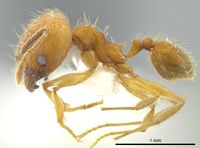Pheidole dasypyx
| Pheidole dasypyx | |
|---|---|

| |
| Scientific classification | |
| Kingdom: | Animalia |
| Phylum: | Arthropoda |
| Class: | Insecta |
| Order: | Hymenoptera |
| Family: | Formicidae |
| Subfamily: | Myrmicinae |
| Tribe: | Attini |
| Genus: | Pheidole |
| Species: | P. dasypyx |
| Binomial name | |
| Pheidole dasypyx Wilson, 2003 | |
Nothing is known about the biology of dasypyx.
Identification
See the description in the nomenclature section.
Keys including this Species
Distribution
Known from Costa Rica and Panama.
Latitudinal Distribution Pattern
Latitudinal Range: 9.166667° to 9.15°.
| North Temperate |
North Subtropical |
Tropical | South Subtropical |
South Temperate |
- Source: AntMaps
Distribution based on Regional Taxon Lists
Neotropical Region: Costa Rica, Panama (type locality).
Distribution based on AntMaps
Distribution based on AntWeb specimens
Check data from AntWeb
Countries Occupied
| Number of countries occupied by this species based on AntWiki Regional Taxon Lists. In general, fewer countries occupied indicates a narrower range, while more countries indicates a more widespread species. |

|
Estimated Abundance
| Relative abundance based on number of AntMaps records per species (this species within the purple bar). Fewer records (to the left) indicates a less abundant/encountered species while more records (to the right) indicates more abundant/encountered species. |

|
Biology
Castes
Worker
Minor
Images from AntWeb
    
| |
| Paratype Pheidole dasypyx. Worker. Specimen code casent0627923. Photographer Jeremy Pilllow, uploaded by University of Utah. | Owned by MCZC. |
Major
Images from AntWeb

| |
| Paratype Pheidole dasypyx. Worker (major/soldier). Specimen code jtlc000016358. Photographer Jeremy Pilllow, uploaded by University of Utah. | Owned by MCZC. |
Nomenclature
The following information is derived from Barry Bolton's Online Catalogue of the Ants of the World.
- dasypyx. Pheidole dasypyx Wilson, 2003: 612, figs. (s.w.) PANAMA.
Unless otherwise noted the text for the remainder of this section is reported from the publication that includes the original description.
Description
DIAGNOSIS Major: distinguished within the punctatissima group by the combination of the 3-lobed promesonotal profile in side view, with the mesonotal (rearmost) convexity flat-topped; long, robust propodeal spine; completely rugulose posterior half of the head, reaching all the way to the occiput; completely foveolate and opaque first gastral tergite; and dense pilosity.
Minor: head, mesosoma, and waist entirely foveolate and opaque; occiput narrow, with a very thin nuchal collar.
Both castes are yellow.
MEASUREMENTS (mm) Holotype major: HW 0.96, HL 0.94, SL 0.66, EL 0.16, PW 0.40. Paratype minor: HW 0.46, HL 0.54, SL 0.68, EL 0.10, PW 0.32.
COLOR Major and minor: concolorous medium yellow.
Figure. Upper: holotype, major. Lower: paratype, minor. Scale bars = 1 mm. [Specimen Labels]
Type Material
PANAMA: Barro Colorado Island, col. William L. Brown. Museum of Comparative Zoology
Etymology
Gr dasypyx, hairy rump, referring to the dense pilosity of the gaster.
References
- Wilson, E. O. 2003. Pheidole in the New World: A dominant, hyperdiverse ant genus. Harvard University Press, Cambridge, MA. (page 612, fig. major, minor described)
References based on Global Ant Biodiversity Informatics
- Donoso D. A. 2014. Assembly mechanisms shaping tropical litter ant communities. Ecography 37 doi: 10.1111/j.1600-0587.2013.00253.x
- Fernández, F. and S. Sendoya. 2004. Lista de las hormigas neotropicales. Biota Colombiana Volume 5, Number 1.
- Kaspari M., D. Donoso, J. A. Lucas, T. Zumbusch, and A. D. Kay. 2012. Using nutritional ecology to predict community structure: a field test in Neotropical ants. Ecosphere 3(11): art.93.


